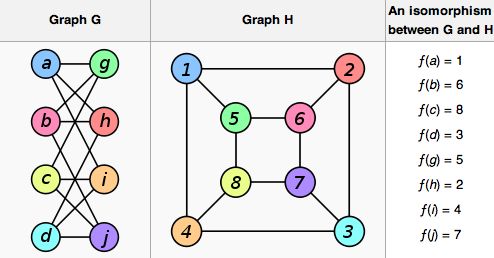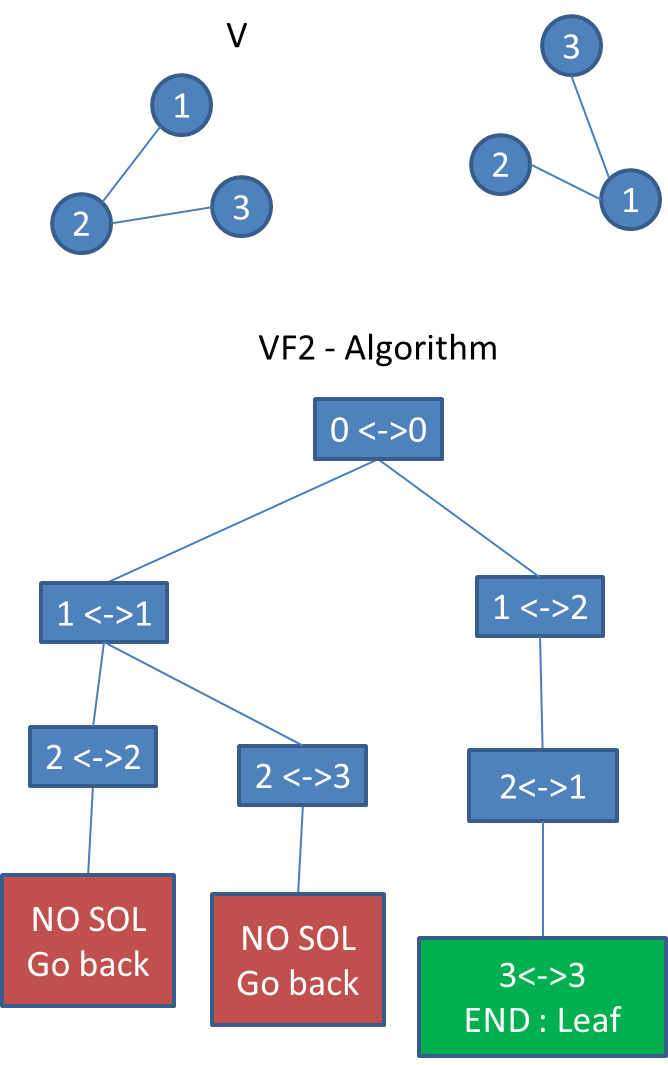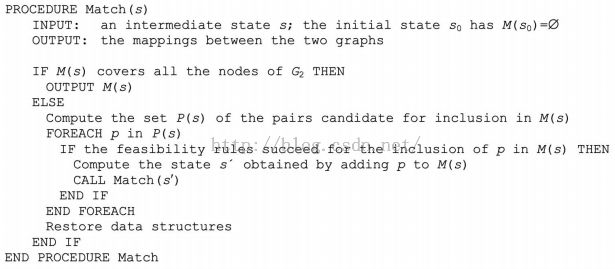(子)图同构算法VF2实现(1)
子图同构问题本质上就是一种匹配,VF2算法加了很多feasibility rules,保证了算法的高效性。这里只是实现最基本的判断子图同构的算法:
参考文献有(其实google一把就能出来这些):
http://stackoverflow.com/questions/8176298/vf2-algorithm-steps-with-example
http://www.zhihu.com/question/27071897
https://github.com/fozziethebeat/S-Space/tree/master/src/main/java/edu/ucla/sspace/graph/isomorphism
http://stackoverflow.com/questions/6743894/any-working-example-of-vf2-algorithm/6744603
Luigi P. Cordella,Pasquale Foggia,Carlo Sansone,Mario Vento: A (Sub)Graph Isomorphism Algorithm for Matching Large Graphs.IEEE Trans. Pattern Anal. Mach. Intell. 26(10): 1367-1372 (2004)
第一个链接给了一个示例:
http://stackoverflow.com/questions/8176298/vf2-algorithm-steps-with-example:
I will try to give you a quick explaination of my previous answer to this question :
Any working example of VF2 algorithm?
I will use the same example as the one in my previous answer :
The 2 graphs above are V and V' .(V' is not in the drawing but it's the one on the right)
The VF2 algorithm is described in the graph.
Step by step
I want to know if V and V' are isomorphic.
I will use the following notations : XV is the node X in V
In the VF2 algoritm I will try to match each node in V with a node in V'.
step 1 :
I match empty V with empty V' : it always works
step 2 : I can match 1V with 1V',2V' or 3V'
I match 1V witch 1V' : it always works
step 3 :
I can match 2V with 2V' or 3V'
I match 2V with 2V' : it works because {1V 2V} and {1V' 2V} are isomorphic
step 4 :
I try to match 3V with a node in V' : I cannot! {it would be possible if their was an edge between node 3 and 2 in V', and no edge between 3 and 1)
So I go back to step 2
step 5:
I match 2V with 3V'
step 6:
same as step 4
I go back to step 2. there is no solution in step 2 , I go back to step 1
step 7:
I match 1V with 2V'
step 8:
I match 2V with 1V'
step 9 :
I match 3V with 3V'
it works I matched {1V 2V 3V} with { 2V' 1V' 3V'}
The graphs are isomorphic.
If I test all the solution and it never works the graph would not be isomorphic.
Hope this helps
About you're question on "matching", have a look at the wikipedia article on graph isomorphis :
http://en.wikipedia.org/wiki/Graph_isomorphism
this is a good example of a function f that matches graph G and H : 
Hope you can better understand this algorithm with this illustration.
下面给出我的算法设计(这里考虑边和点除了ID之外,还有label):
边和图结构:
struct EDGE
{
int id2;
int label;
EDGE(int _id2, int _label)
{
id2=_id2;
label=_label;
}
};
//邻接链表结构,不过是用vector来实现
struct GRAPH
{
int graphID;
vector<int> vID;
vector<int> vLabel;
vector<vector<EDGE> > vAdjacencyEdge;
//外面的大vector< >,为每一个节点保存一个邻接表,一个图中有多少个节点,vAdjacencyEdge的size就是多少
//vector<EDGE>存放EDGE[id2,label]组元,表示每个节点对应的兄弟节点id以及这两个节点间的边的label,
//vector<EDGE>大小由每个节点的兄弟数量决定(这里所谓的兄弟,就是指“邻接点”)
//因为可行pair(m,n)就是从当前状态M(s)的邻接点中寻找的,所以该结构能够加快搜索速度
};
每一个match结构:
//match结构,对应论文中提到的core_1 and core_2,
//whose dimensions correspond to the number of nodes in G1 and G2
struct MATCH
{
//int *dbMATCHqu; //存储DB中的节点id和与之match的QU中的节点id
//int *quMATCHdb; //存储QU中的节点id和与之match的DB中的节点id
//使用map编程更方便,查找速度更快!
map<int, int> dbMATCHqu;
map<int, int> quMATCHdb;
};
从文件中读取数据(主要是保证每个点的邻接边/点能够按照struct GRAPH正确存储):
vector<GRAPH *> ReadGraph(const char *filename)
{
FILE *fp = fopen(filename, "r");
/*
if (!fp)
{
printf("fp is NULL, file [%s] doesn't exist...\n", filename);
return;
}
*/
EDGE e(-1,-1);
vector<EDGE> v;
v.push_back(e);
char mark[2];
int id,label,id2;
vector<GRAPH *> gSet;
GRAPH * g = NULL;
while(true)
{
fscanf(fp, "%s", mark);
if(mark[0]=='t')
{
fscanf(fp, "%s%d", mark, &id);
if(id==-1)
{
gSet.push_back(g);
break;
}
else //if input not ending, then
{
if(g!=NULL)
{
gSet.push_back(g);
}
g = new GRAPH;
g->graphID=id;
}
}
else if(mark[0]=='v')
{
fscanf(fp, "%d%d", &id, &label);
g->vID.push_back(id);
g->vLabel.push_back(label);
g->vAdjacencyEdge.push_back(v);//为每个节点申请一个vAdjacencyEdge,其中v只是占用位置,没有任何用处!
}
else if(mark[0]=='e')
{
fscanf(fp, "%d%d%d", &id, &id2, &label);
e.id2=id2; e.label=label;
g->vAdjacencyEdge[id].push_back(e);//id->id2的边
e.id2=id; e.label=label;
g->vAdjacencyEdge[id2].push_back(e);//id2->id的边
}
}
fclose(fp);
printf("graph number:%d\n", gSet.size());
return gSet;
}
判断一个候选pair是否满足feasibility rules:
//其实 pair(quG->vID[i], dbG->vID[j])就是一个候选pair candidate
//判断该候选pair是否满足feasibility rules
bool FeasibilityRules(GRAPH *quG, GRAPH *dbG, MATCH match, int quG_vID, int dbG_vID)
{
int quVid,dbVid,quGadjacencyEdgeSize,dbGadjacencyEdgeSize,i,j;
bool flag=false;
//首先,判断quG_vID和dbG_vID对应的label是否相同
if(quG->vLabel[quG_vID]!=dbG->vLabel[dbG_vID]) //如果两个点的label不同,则【一定不】满足feasibility rules
{
return false;
}
//其次,判断是不是每次match的第一个比较pair
if(match.quMATCHdb.size()==0) //如果是第一个比较pair
{
//只需要这两个点的label相同(已经判断成立了)即满足feasibility rules
return true;
}
//最后(label相同,不是第一个pair【即,之前已经match了一部分节点】),那么只要下面条件成立就能满足最简单的feasibility rules:
//1)quG_vID和dbG_vID与已经match的那些节点对中的【至少】一对(quVid,dbVid)分别相邻(quG_vID和dbG_vID分别是已经match的节点quVid和dbVid的“neighbor节点”)
//2)如果存在多个相邻对(quVid,dbVid),则必须要求【所有的】邻接边对( edge(quG_vID,quVid), edge(dbG_vID,dbVid) )的label一样
for(map<int, int>::iterator iter=match.quMATCHdb.begin();iter!=match.quMATCHdb.end();iter++) //遍历所有的已经match的节点对
{
quVid=iter->first;
quGadjacencyEdgeSize=quG->vAdjacencyEdge[quVid].size();
for(i=1;i<quGadjacencyEdgeSize;i++) //从1开始依次扫描quVid的邻接点,第0个存的是(-1,-1)
{
//quG_vID是已经match的quG中的节点quVid的“第i个neighbor节点”
if( quG->vAdjacencyEdge[quVid][i].id2==quG_vID )
{
dbVid=iter->second;
dbGadjacencyEdgeSize=dbG->vAdjacencyEdge[dbVid].size();
for(j=1;j<dbGadjacencyEdgeSize;j++) //从1开始依次扫描dbVid的邻接点,第0个存的是(-1,-1)
{
//同时,与quVid相match的节点dbVid在dbG中的“第j个neighbor节点”正好是dbG_vID
if( dbG->vAdjacencyEdge[dbVid][j].id2==dbG_vID )
{
//判断2)是否成立
if( quG->vAdjacencyEdge[quVid][i].label != dbG->vAdjacencyEdge[dbVid][j].label )
{
//因为2)要求【所有的】label一样,只要有一个不一样,则返回false
return false;
}
else
{
//标记:flag=true表示至少有一对满足1)的pair(dbVid,quVid),同时满足了2)
//因为有可能循环结束了,在所有的已经match的节点对里,找不到一个pair(dbVid,quVid)同时满足条件1)和2)
flag=true;
}
}
}
}
}
}
return flag;
}
最后给出该算法的伪代码:

